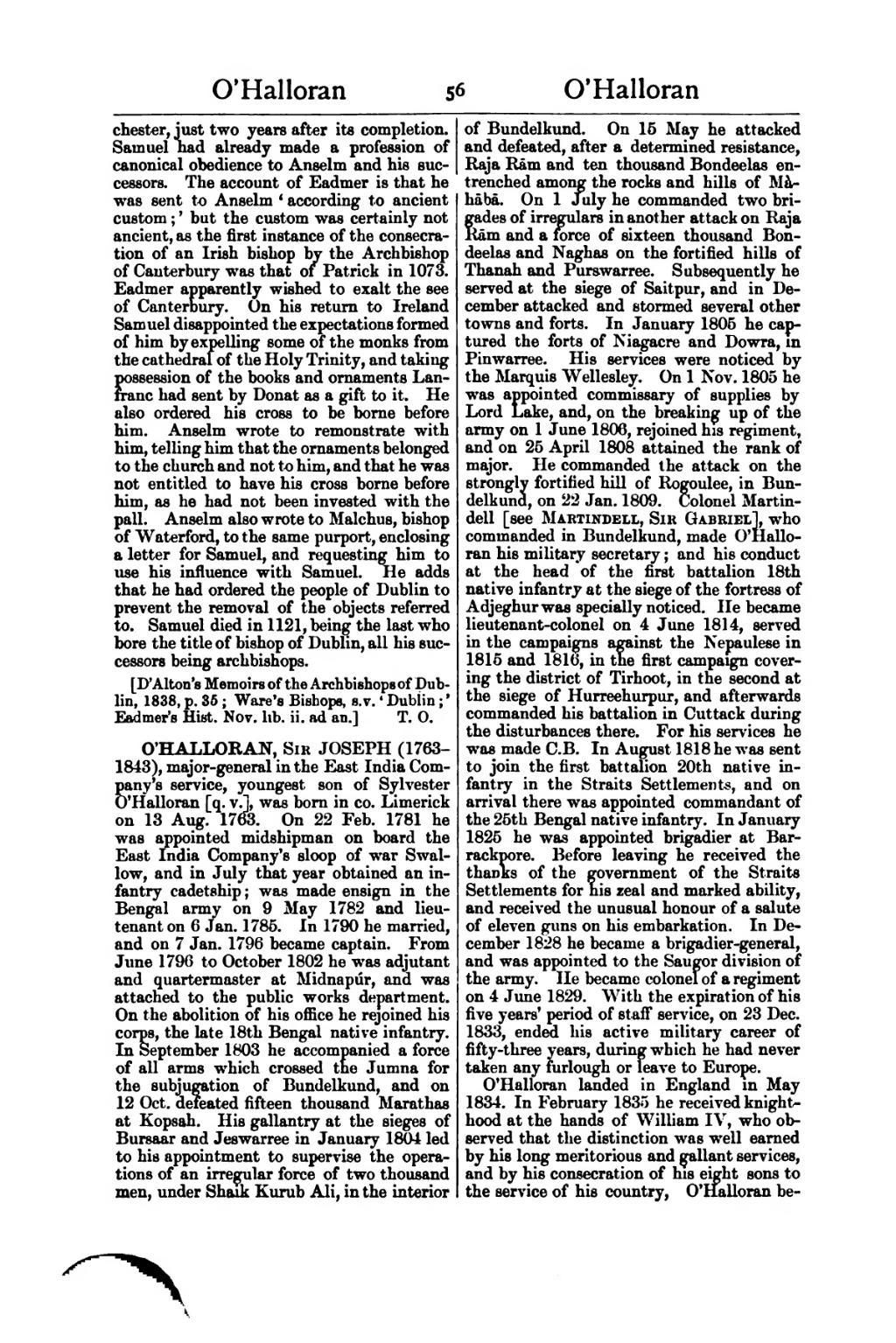chester, just two years after its completion. Samuel had already made a profession of canonical obedience to Anselm and his successors. The account of Eadmer is that he was sent to Anselm 'according to ancient custom;' but the custom was certainly not ancient, as the first instance of the consecration of an Irish bishop by the Archbishop of Canterbury was that of Patrick in 1073. Eadmer apparently wished to exalt the see of Canterbury. On his return to Ireland Samuel disappointed the expectations formed of him by expelling some of the monks from the cathedral of the Holy Trinity, and taking possession of the books and ornaments Lanfranc had sent by Donat as a gift to it. He also ordered his cross to be borne before him. Anselm wrote to remonstrate with him. telling him that the ornaments belonged to the church and not to him, and that he was not entitled to have his cross borne before him, as he had not been invested with the pall. Anselm also wrote to Malchus, bishop of Waterford, to the same purport, enclosing a letter for Samuel, and requesting him to use his influence with Samuel. He adds that he had ordered the people of Dublin to prevent the removal of the objects referred to. Samuel died in 1121, being the last who bore the title of bishop of Dublin, all his successors being archbishops.
[D'Alton's Memoirs of the Archbishops of Dublin, 1838, p. 35; Ware's Bishop's. s.v. 'Dublin;' Eadmer's Hist. Nov. lib. ii. ad an.]
O'HALLORAN, Sir JOSEPH (1763–1843), major-general in the East India Company's service, youngest son of Sylvester O'Halloran [q. v.], was born in co. Limerick on 13 Aug. 1763. On 22 Feb. 1781 he was appointed midshipman on board the East India Company's sloop of war Swallow, and in July that year obtained an infantry cadetship; was made ensign in the Bengal army on 9 May 1782 and lieutenant on 6 Jan. 1785. In 1790 he married, and on 7 Jan. 1796 became captain. From June 1796 to October 1802 he was adjutant and quartermaster at Midnapúr, and was attached to the public works department. On the abolition of his office he rejoined his corps, the late 18th Bengal native infantry. In September 1803 he accompanied a force of all arms which crossed the Jumna for the subjugation of Bundelkund, and on 12 Oct. defeated fifteen thousand Marathas at Kopsah. His gallantry at the sieges of Bursaar and Jeswarree in January 1804 led to his appointment to supervise the operation irregular force of two thousand men, under Shaik Kurub Ali, in the interior of Bundelkund. On 15 May he attacked and defeated, after a determined resistance, Raja Rām and ten thousand Bondeelas entrenched amonng the rocks and hills of Màhābā. On 1 July he commanded two brigades of irregulars in another attack on Raja Rām and a force of sixteen thousand Bondeelas and Naghas on the fortified hills of Thanah and Purswarree. Subsequently he served at the siege of Saitpur, and in December attacked and stormed several other towns and forts. In January 1805 he captured the forts of Niagacre and Dowra, in Pinwarree, His services were noticed by the Marquis Wellesley. On 1 Nov. 1805 he was appointed commissary of supplies by Lord Lake, and, on the breaking up of the army on 1 June 1806, rejoined his regiment, and on 25 April 1808 attained the rank of major. He commanded the attack on the strongly fortified hill of Rogoulee, in Bundelkund, on 22 Jan. 1809. Colonel Martindell [see Martindell, Sir Gabriel], who commanded in Bundelkund, made O'Halloran his military secretary; and his conduct at the head of the first battalion 18th native infantry at the siege of the fortress of Adjeghur was specially noticed. He became lieutenant-colonel on 4 June 1814, served in the campaigns against the Nepaulese in 1815 and 1816, in the first campaign covering the district of Tirhoot, in the second at the siege of Hurreehurpur, and afterwards commanded his battalion in Cuttack during the disturbances there. For his services he was made C.B. In August 1818 he was sent to join the first battalion 20th native infantry in the Straits Settlements, and on arrival there was appointed commandant of the 25th Bengal native infantry. In January 1825 he was appointed brigadier at Barrackpore. Before leaving he received the thanks of the government of the Straits Settlements for his zeal and marked ability, and received the unusual honour of a salute of eleven guns on his embarkation. In December 1828 he became a brigadier-general, and was appointed to the Saugor division of the army. He became colonel of a regiment on 4 June 1829. With the expiration of his five years' period of staff service, on 23 Dec. 1833, ended his active military career of fifty-three years, during which he had never taken any furlough or leave to Europe.
O'Halloran landed in England in May 1834. In February 1835 he received knighthood at the hands of William IV, who observed that the distinction was well earned by his long meritorious and gallant services, and by his consecration of his eight sons to the service of his country, O'Halloran be-

